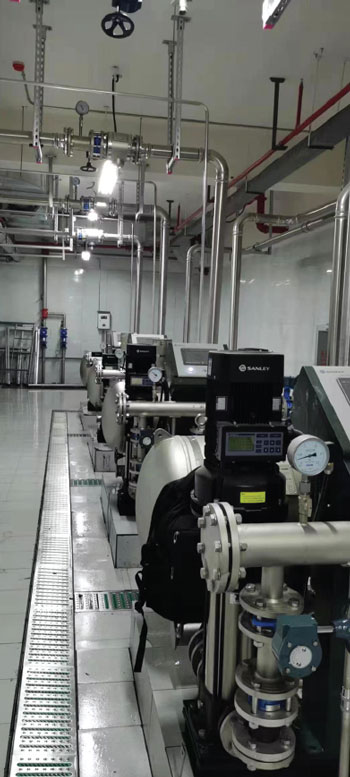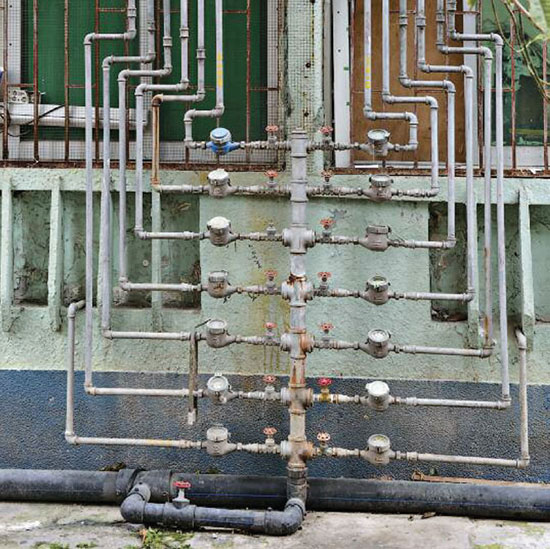One in three people worldwide live without access to clean drinking water. Even major cities with established utilities are projected to fall short of demand for potable water. One of these cities is Shenzhen: China’s first free-trade zone and unofficial innovation capital. An ambitious plan specifies molybdenum-containing Type 316 stainless steel distribution systems as a solution to water loss.
By Fabio Ries, IMOA
In 1980, Shenzhen was a sleepy fish-ing village of a few thousand. One taxi pulling a wooden cart served the whole town. Today, it’s a bustling city of 17.5 million people and an innovation and tech hub, indispensable to the global supply chain. Shenzhen’s location on China’s southern coast, adjoining Hong Kong, made it the ideal testing ground for the export-driven economic model that defines the modern era. Shenzhen sees the growing reliance on its strained water resources not as a hurdle, but as a catalyst for better infrastructure. The city unveiled targets for improved water resources by 2025, even promising a clean drink from the tap – a first for modern China. Type 316 stainless steel secondary water supply systems are being implemented across Shenzhen to minimize wastage of this most precious resource. With support from the central government, it is expected that other municipalities will emulate Shenzhen’s plan and reduce leakage throughout the country.
Secondary water systems
Secondary water supply systems transport water from the mainline under the street to the tap in multi-story buildings. These systems began to proliferate in China during the late 1980s and early 1990s. It was the first time high-rise apartment communities with indoor plumbing were built for ordinary city dwellers, and these facilities soon became symbols of the new prosperity.
The typical secondary water supply system starts with the “snap tap”.Water is directed from the main through this snap tap into a secondary pipe and then to a tank for buffer storage. In higher buildings, pressure is added through pumps, regulated by frequency inverters to adjust to variable flow rates, which guarantees reliable supply with maximum energy efficiency.

Troubled waters
In China, secondary water systems were made traditionally with galvanized steel, ductile iron or plastic, which all suffer leakage problems. The World Bank estimates global water demand will exceed supply by 40% in less than 10 years. Yet, approximately 25% to 30% of the world’s treated drinking water supply is wasted through leakage. Some regions lose well over half of their water during distribution. It’s not just water that’s wasted – the resources used to treat, store and transport it are also squandered. But most importantly, this loss creates a risk for water shortages, especially during droughts, which are increasing due to climate change. Most leakage occurs in the final leg of distribution, in the “service lines” , underground pipes that carry water from the mainline to the meter at individual residences and businesses. Installing stainless steel service lines is associated with dramatic reductions in both leakage rates and repair cases, saving cities like Tokyo valuable water resources as well as billions of dollars over the life of the system.
China is home to almost 20% of the world’s population, but only to 7% of its freshwater resources. Water is unevenly distributed: the north and west are parched while the south swells with seasonal heavy rains. Severe pollution, which makes over 60% of ground water and 25% of rivers and lakes unfit for human contact, does not help. 20% of China’s fresh water is unfit even for industrial or agricultural use. The signature South-to-North Water Diversion Project, the costli-est engineering work in human history, has shown only meager results in alleviating chronic water scarcity in Northern China’s densely populated plains. Shenzhen, with major pollution and an ever -growing population, knows these water woes all too well. Shenzhen does not have any deep major rivers, only rain-dependent surface waters, fed by seasonal monsoons. Quality and availability of water varies widely from month to month and year to year. The estuaries that once helped to clean and stabilize water levels have been drained for industrial development. Shenzhen must look for other solutions. By 2025, the city hopes to increase the volume and quality of its water supply through capturing and reusing rainwater, better integration of stakeholders and maintenance practices, establishing new reservoirs and outfitting all residences with stainless steel secondary water systems.
Spotlight on Shenzhen
Shenzhen’s water utility identified the secondary water supply systems as key failure points during distribution. This is where energy consumption is highest, as well as where leakage and contamination are most likely to occur. The new secondary systems in Shenzhen are therefore fully automated, with flow meters and cameras installed at various points of the line to monitor rates and regulate valves and pumping capacity.
They are integrated into one smart control system together with the water works and the main municipal supply line.
Trials for system replacement have been carried out in Shenzhen since 2010 in selected urban districts, before the complete campaign began in 2017 . After testing and comparing different materials, Type 316L stainless steel was specified as mandatory for all tubes, fittings and water tanks in secondary systems, no matter whether installed outside, underground or in the walls. For valves, pumps and meters, the use of Type 316L stainless steel is not yet mandatory but strongly recommended.
The Shenzhen Water Group (SWG) chose Type 316L stainless steel for strength, resistance to corrosion, ease of maintenance and cleaning, long service life and recyclability. Corrosion is a major issue in Shenzhen due to its humid coastal location with a high salt content both in the air and in the soil. Elevated levels of air pollution also create conditions for particulates to stick to surfaces, which can cause atmospheric corrosion. In addition to improved corrosion resistance, thanks to its 2.2% molybde-num content, Type 316L stainless steel offers a long-lasting clean and neat appearance when installed on the exterior of retrofitted buildings. One further factor is the broad availability of stainless steel products in China. In the past five years, Chinese tube and pipe manufacturers have increased three-fold.
Installation of the new systems is supported through a publicly-funded campaign to overhaul residential areas built before 2000 to comply with new standards. The water authority aims to install compliant secondary systems for all Shenzhen residents by 2025. In 2018, Shenzhen’s Yantian District, home to 2.7 million people, became the first district with stainless steel secondary systems and increased tap water quality.


Beyond Shenzhen
Following in Shenzhen’s footsteps, a campaign to overhaul older secondary water systems took off nationwide in 2018, targeting 110 million people from 160,000 residential areas over five years. 20,000 upgrades were completed in 2019, while more than 40,000 followed in 2020. The outbreak of Covid-19 sparked a new urgency to the campaign, furthering the government’s promotion of health and safety while also stimulating the economy. Greeted by general enthusiasm, the campaign is largely ahead of schedule, and more public funds will be available to sustain its long term viability. In total, over 200 million homes are targeted for secondary water system upgrades or installation. As a rough estimate, some 15,000 tonnes of molybdenum may be needed over the next five years to achieve these targets – an annualized average that would be equivalent to more than 1% of all new Mo produced in 2020.
To further promote the stainless steel secondary water systems, the Shenzhen utility held a “National Conference on Secondary Water Supply Systems” . This conference brought together academics, utilities, and suppliers from across the country to study the Shenzhen case in depth. “Shenzhen Water University” , a platform for research and exchange for stakeholders in the water industry, also helps to promote Shenzhen’s approach. By acquiring shares in local water utilities across China, SWG hopes to export its successful model and advanced operational experience across the country. Already, water utilities in the cities of Fuzhou, Haikou and Zhuhai have shown a strong commitment to “study Shenzhen’s experience” , while several districts in Shanghai and Suzhou have made Type 316L stainless steel mandatory on a trial basis. In 2020, the city of Hangzhou upgraded over 100 secondary water systems with a combination of Type 304 and Type 316 stainless steel components. Other cities and provinces, while mandating “stainless steel grade 304 or higher” in their local specifications, strongly recommend Type 316L for use in public buildings or external applications.
Time is running out to secure enough clean water for future generations. But cases like Shenzhen highlight that solutions are available, even when the challenges seem insurmountable. The new stainless steel secondary water systems, sparkling in the sun as they climb up the side of the city’s high rises, are a visible reminder that clean water for all is possible.
China’s secondary water system upgrade in numbers
Countrywide, 200+ million homes need upgrades.
1st phase target (2019 – 2023): 160,000 residential areas 110 million people
By 2020 completed: 60,000 residential areas 41 million people


